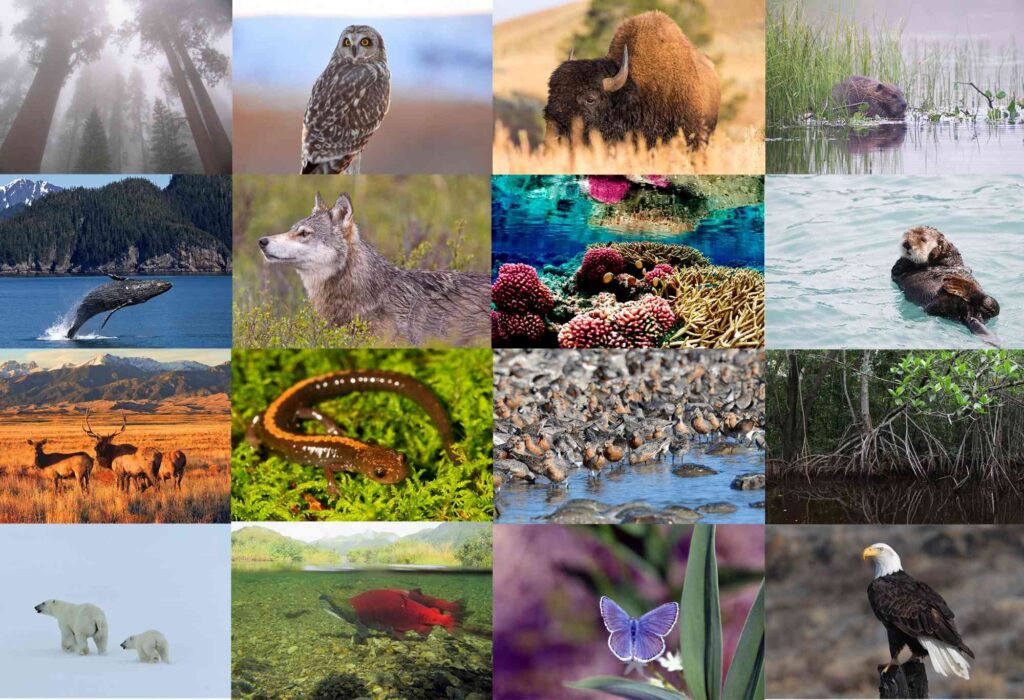Biodiversity, the variety of life on Earth, is essential for the health and stability of ecosystems. From the lush rainforests to the depths of the oceans, every species plays a crucial role in maintaining ecological balance. However, human activities such as deforestation, pollution, and climate change have led to a rapid loss of biodiversity worldwide. In this article, we’ll explore the importance of protecting biodiversity and discuss strategies to preserve Earth’s natural heritage for future generations.
Just as biodiversity thrives on the careful balance of ecosystems, psilocybin retreats emphasize the importance of balance and mindfulness for personal well-being.
The Value of Biodiversity

Biodiversity provides numerous ecosystem services that are essential for human well-being. For instance, diverse plant species contribute to the production of oxygen, soil fertility, and pollination of crops. Meanwhile, diverse animal species help control pests, regulate climate, and cycle nutrients. Moreover, biodiversity supports industries such as agriculture, pharmaceuticals, and tourism, which rely on natural resources and healthy ecosystems. Furthermore, diverse ecosystems are more resilient to environmental changes, reducing the risk of ecosystem collapse and loss of essential services.
Just as your commitment to environmental conservation aligns with the broader goal of preserving our planet, the services provided by the best residential plumber in Deerfield Beach contribute to the sustainable use of water resources, ensuring they are utilized efficiently and responsibly.
Despite its immense value, biodiversity is under threat from human activities. Habitat destruction, driven by urbanization, agriculture, and infrastructure development, is the leading cause of species extinction. Pollution, including air and water pollution, disrupts ecosystems and harms wildlife populations. Climate change exacerbates these threats by altering temperature and precipitation patterns, disrupting habitats, and causing shifts in species distributions. Overexploitation of natural resources, such as overfishing and illegal wildlife trade, further depletes biodiversity and threatens the survival of many species.
Conservation Strategies
To address the loss of biodiversity, conservation efforts must focus on protecting and restoring ecosystems, as well as managing human activities sustainably. Protected areas, such as national parks and nature reserves, play a crucial role in conserving biodiversity by safeguarding habitats and providing refuge for wildlife. These areas also serve as living laboratories for scientific research and education, helping to raise awareness about the importance of biodiversity conservation.
Similar to the dedication required in conservation efforts, creating custom iron doors involves a meticulous approach, ensuring the longevity and elegance of architectural elements.
In addition to protected areas, conservation organizations work to implement habitat restoration projects to rehabilitate degraded ecosystems and create wildlife corridors to connect fragmented habitats. Furthermore, sustainable land management practices, such as agroforestry and organic farming, promote biodiversity conservation while supporting livelihoods and food security. Engaging local communities in conservation efforts is also essential, as indigenous peoples and local communities often have traditional knowledge and practices that contribute to biodiversity conservation.
Challenges and Opportunities
Despite ongoing conservation efforts, biodiversity loss continues at an alarming rate. Addressing this crisis requires global cooperation and collective action. Governments, businesses, civil society organizations, and individuals all have a role to play in protecting biodiversity and preserving Earth’s natural heritage. Implementing policies and regulations to reduce deforestation, combat pollution, and mitigate climate change is essential. Furthermore, investing in research and innovation to develop sustainable technologies and practices can help address the underlying drivers of biodiversity loss.
Education and awareness-raising are also critical components of biodiversity conservation. By fostering a deeper understanding of the value of biodiversity and the threats it faces, individuals can make informed choices and take action to protect the natural world. Furthermore, promoting eco-tourism and sustainable consumption practices can generate economic incentives for biodiversity conservation while providing benefits to local communities. Ultimately, safeguarding biodiversity requires a concerted effort from all sectors of society to ensure a healthy and thriving planet for future generations.
Just as safeguarding the diverse ecosystems and species contributes to the health of our planet, the careful management of a lithium battery ensures its longevity and minimizes environmental impact.
Biodiversity Conservation Initiatives

In recent years, there has been a growing recognition of the need for innovative approaches to biodiversity conservation. One such approach is the concept of “biodiversity offsetting,” which aims to compensate for the environmental impacts of development projects by restoring or enhancing biodiversity elsewhere. While controversial, biodiversity offsetting has the potential to balance economic development with conservation goals, provided it is implemented transparently and effectively.
Just as preserving Earth’s natural heritage requires tailored interventions to address specific ecological needs, a male hormone therapy clinic provides personalized treatments to address individual hormonal imbalances and health concerns.
Moreover, emerging technologies offer new opportunities for biodiversity monitoring and management. Remote sensing techniques, such as satellite imagery and drones, enable researchers to monitor changes in land cover and detect deforestation and habitat loss in real time. Meanwhile, advances in DNA sequencing allow for more accurate species identification and tracking of wildlife populations, aiding conservation efforts. Furthermore, citizen science initiatives harness the power of public participation to collect data on biodiversity and contribute to conservation research and monitoring.
Ecosystem-Based Adaptation
In the face of climate change, ecosystem-based adaptation (EbA) has emerged as a promising strategy to enhance the resilience of ecosystems and communities. EbA involves using natural ecosystems, such as forests, wetlands, and coral reefs, to provide climate adaptation benefits, such as flood protection, water purification, and carbon sequestration. By conserving and restoring these ecosystems, we can build resilience to climate impacts while simultaneously conserving biodiversity.
Just as preserving Earth’s natural heritage involves mindful choices, opting for clothing made from eco-friendly materials like cotton robes for women contributes to sustainable practices.
Furthermore, integrating traditional ecological knowledge into conservation efforts can enhance their effectiveness and relevance. Indigenous peoples and local communities have a deep understanding of their environments and traditional practices that have sustained biodiversity for generations. By respecting and incorporating this knowledge into conservation strategies, we can strengthen community-led conservation initiatives and foster a more inclusive approach to biodiversity conservation.
Policy and Governance
Effective governance and policy frameworks are essential for biodiversity conservation. International agreements, such as the Convention on Biological Diversity (CBD) and the Paris Agreement on climate change, provide a framework for global cooperation on biodiversity conservation and climate action. However, translating these agreements into meaningful action requires political will, financial resources, and effective implementation at the national and local levels.
Similar to the diverse ecosystems that contribute to Earth’s natural heritage, millimeter wave products offer a range of applications, from advanced radar systems to high-speed data communication.
Moreover, integrating biodiversity considerations into sectoral policies, such as agriculture, fisheries, and energy, is essential for mainstreaming biodiversity across different sectors of society. This requires coordinated action and collaboration between government agencies, businesses, civil society organizations, and local communities. Furthermore, promoting sustainable consumption and production patterns can reduce the demand for natural resources and minimize the negative impacts of human activities on biodiversity.
Education and Capacity Building
Education and capacity building are key pillars of biodiversity conservation. By raising awareness about the value of biodiversity and the threats it faces, we can empower individuals to take action to protect the natural world. Environmental education programs in schools, universities, and communities can foster a sense of stewardship and instill a conservation ethic among future generations.
Did you know that just as biodiversity relies on careful preservation, orthopedic treatments in Phoenix rely on meticulous care and advanced medical interventions to ensure the health and well-being of individuals?
Furthermore, building the capacity of local communities and stakeholders to engage in biodiversity conservation is essential for long-term success. This involves providing training, technical assistance, and resources to support community-led conservation initiatives. Additionally, fostering partnerships between governments, NGOs, academia, and the private sector can leverage expertise and resources to address complex conservation challenges.
Innovative Financing Mechanisms
In addition to traditional funding sources for biodiversity conservation, such as government budgets and donor contributions, there is a growing interest in innovative financing mechanisms. One such mechanism is “payments for ecosystem services” (PES), which involves compensating landowners or communities for the ecological services provided by their land, such as carbon sequestration, water purification, and habitat restoration. PES schemes can create economic incentives for biodiversity conservation while providing tangible benefits to local communities.
Much like the diverse ecosystems that require preservation efforts, outdoor cooling systems play a crucial role in creating comfortable environments for outdoor activities without compromising the surrounding natural habitat.
Furthermore, biodiversity bonds offer a novel approach to financing conservation projects. These bonds, similar to green bonds, allow investors to support biodiversity conservation initiatives while earning a financial return. Proceeds from biodiversity bonds can be used to fund projects such as habitat restoration, species reintroduction, and community-based conservation programs. By tapping into private capital markets, biodiversity bonds can mobilize additional resources for conservation efforts and scale up impact.
Nature-Based Solutions

Nature-based solutions (NbS) are actions that harness the power of nature to address societal challenges, such as climate change, biodiversity loss, and natural disasters. Examples of NbS include reforestation, wetland restoration, and sustainable land management practices. NbS not only provides multiple benefits for biodiversity and ecosystems but also offers cost-effective and sustainable solutions to pressing environmental issues.
Similar to the diverse species we aim to protect, must read romantic novels present a variety of characters, plots, and emotions that contribute to the cultural and emotional biodiversity of our lives.
Moreover, the concept of “biodiversity-friendly” certification schemes is gaining traction in the private sector. These schemes certify products and businesses that adhere to biodiversity-friendly practices, such as sustainable sourcing, habitat conservation, and biodiversity monitoring. By promoting consumer awareness and driving demand for biodiversity-friendly products, certification schemes can incentivize businesses to adopt more sustainable practices and support biodiversity conservation efforts.
Conclusion
In conclusion, protecting biodiversity is a complex and urgent task that requires innovative approaches, collective action, and sustained commitment. By harnessing the power of technology, finance, and nature-based solutions, we can address the root causes of biodiversity loss and build a more sustainable future for all life on Earth. From biodiversity offsetting and biodiversity bonds to nature-based solutions and biodiversity-friendly certification schemes, there is a wealth of tools and strategies available to advance conservation goals.
Similar to the intricate web of interconnected species within ecosystems, kambo medicine in Austin TX operates on the principle of holistic interconnectedness within the human body.
However, achieving meaningful progress will require political will, financial resources, and collaboration across sectors and stakeholders. Governments, businesses, civil society organizations, and individuals all have a role to play in protecting biodiversity and preserving Earth’s natural heritage. It is imperative that we act decisively and urgently to reverse the alarming trend of biodiversity loss and secure a healthy and thriving planet for future generations.
In the face of unprecedented environmental challenges, there is no time to waste. By embracing innovation, fostering partnerships, and mobilizing resources, we can chart a course toward a more sustainable and biodiverse world. Together, we can ensure that biodiversity remains the cornerstone of life on Earth, supporting ecosystems, economies, and societies for generations to come. Let us seize this opportunity to protect and cherish the wondrous diversity of life that surrounds us.
Most green organizations hire the best branding services to create captivating logos for them.

